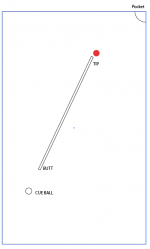Pro One is an objective aiming system.
Have you ever experienced being in a dilemma on which perception to use for a certain shot? Stan advises us that we should test it out so that we can charge it to experience. But as user of Pro One, we want a definitive procedure on how to identify this aim-points. Should we wait for our experience feed us the best and accurate perception to use? The answer is YES, but wouldn't it be fun, and exciting if we know a method that can exactly identify what perception is to use for a given shot? I'm sure it would, because it did for me.
I believe that a perception can be identified by either or all of the following:
But Today I’ll discuss the easiest method, the Shaft Edge Alignment. This method will surely save those whose still in the first step of learning Pro one, those who are confused/dilemma in which perception to use, and those proficient in Pro-One as they can add this technique for teaching or… well just knowing it. Hehehe :thumbup:
Let's Begin
SHAFT EDGE REFERENCES
Our Cue Shaft will be the deciding factor on which perception is to use when coupled with Object Ball Perception Points. There are two simple things to remember:
*Use the EDGE of the shaft which is identical to the direction of the cut.
See Image Below
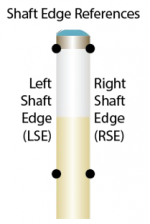
=========================================================================
CUE PIVOTS
See Image Below
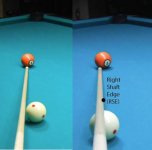
=========================================================================
CONNECTING WITH OBJECT BALL PERCEPTION POINTS
Now that we know how to align, pivot and identify which shaft edge is to use, we now identify which aim perception is to be used for a given shot.
OBJECT BALL PERCEPTION REFERENCES
The image below shows and object ball marked at the quarters with 15, 30, 45 and 60 Degrees.
See Image Below

The following images below show how the object ball is divided by Zones (15°, 30°, 45° and 60°).
Again the deciding factor here is the edge of your shaft (Left or Right)
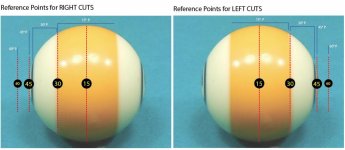
FOR LEFT CUTS If the Left Edge of your shaft falls:
FOR RIGHT CUTS If the RIGHT Edge of your shaft falls:
=========================================================================
SAMPLES (Right Cuts to the Side Pocket) :grin-square:
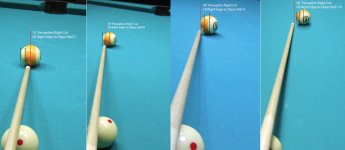
=========================================================================
And that’s it! It’s EASY, SIMPLE & ACCURATE.
Additionally this method can be also used for banking especially if you have knowledge about diamond systems (Zero X Kicks/Banks).
Although testing each perception is advantageous and true, there are times that you can’t wait for experience to kick in.
Thanks to Stan for bringing Pro One. I Hope you (PRO1 users) enjoyed this post.
Have you ever experienced being in a dilemma on which perception to use for a certain shot? Stan advises us that we should test it out so that we can charge it to experience. But as user of Pro One, we want a definitive procedure on how to identify this aim-points. Should we wait for our experience feed us the best and accurate perception to use? The answer is YES, but wouldn't it be fun, and exciting if we know a method that can exactly identify what perception is to use for a given shot? I'm sure it would, because it did for me.
I believe that a perception can be identified by either or all of the following:
- Diamond Calculation (OB & CB Distance, OB distance to Rail/Pocket, CB Distance to Rail/Pocket)
- Shaft Edge Alignment (This Topic)
But Today I’ll discuss the easiest method, the Shaft Edge Alignment. This method will surely save those whose still in the first step of learning Pro one, those who are confused/dilemma in which perception to use, and those proficient in Pro-One as they can add this technique for teaching or… well just knowing it. Hehehe :thumbup:
Let's Begin
SHAFT EDGE REFERENCES
Our Cue Shaft will be the deciding factor on which perception is to use when coupled with Object Ball Perception Points. There are two simple things to remember:
- 1. Left Cut Shots MEANS we’ll use the Left Shaft Edge (LSE)
- 2. Right Cut Shots MEANS we’ll use the Right Shaft Edge (RSE)
*Use the EDGE of the shaft which is identical to the direction of the cut.
See Image Below

=========================================================================
CUE PIVOTS
- 1. Align your cue behind the object ball (as close as possible, but don't get fouled) through the center of the intended pocket or aim.
- 2. Now pivot your cue while maintaining the cue tip at rest until we reach the center of our cue ball via specific Pool Cue/Cue Shaft Edge (in this example, it’s the Right Edge because it’s a right cut.)
See Image Below

=========================================================================
CONNECTING WITH OBJECT BALL PERCEPTION POINTS
Now that we know how to align, pivot and identify which shaft edge is to use, we now identify which aim perception is to be used for a given shot.
OBJECT BALL PERCEPTION REFERENCES
The image below shows and object ball marked at the quarters with 15, 30, 45 and 60 Degrees.
See Image Below

The following images below show how the object ball is divided by Zones (15°, 30°, 45° and 60°).
Again the deciding factor here is the edge of your shaft (Left or Right)

FOR LEFT CUTS If the Left Edge of your shaft falls:
- 1) Within 30 & 15 (up to the left quarter of the object ball), then you are to use a 15° Perception (AIM POINT A)
- 2) Within 45 (1 mm inside the actual 45) & 30, then you are to use a 30° Perception. (AIM POINT B)
- 3) Exactly at the right outer edge (45°) the then you are to use a 45° Perception. (AIM POINT C)
- 4) Outside (right) of the object ball, then that’s a 60° Perception (1/8 Overlap).
FOR RIGHT CUTS If the RIGHT Edge of your shaft falls:
- 1) Within 30 & 15 (up to the right quarter of the object ball), then you are to use a 15° Perception (AIM POINT C)
- 2) Within 45 (1 mm inside the actual 45) & 30, then you are to use a 30° Perception. (AIM POINT B)
- 3) Exactly at the left outer edge (45°) the then you are to use a 45° Perception. (AIM POINT A)
- 4) Outside (left) of the object ball, then that’s a 60° Perception (1/8 Overlap).
=========================================================================
SAMPLES (Right Cuts to the Side Pocket) :grin-square:

=========================================================================
And that’s it! It’s EASY, SIMPLE & ACCURATE.
Additionally this method can be also used for banking especially if you have knowledge about diamond systems (Zero X Kicks/Banks).
Although testing each perception is advantageous and true, there are times that you can’t wait for experience to kick in.
Thanks to Stan for bringing Pro One. I Hope you (PRO1 users) enjoyed this post.
Last edited:
